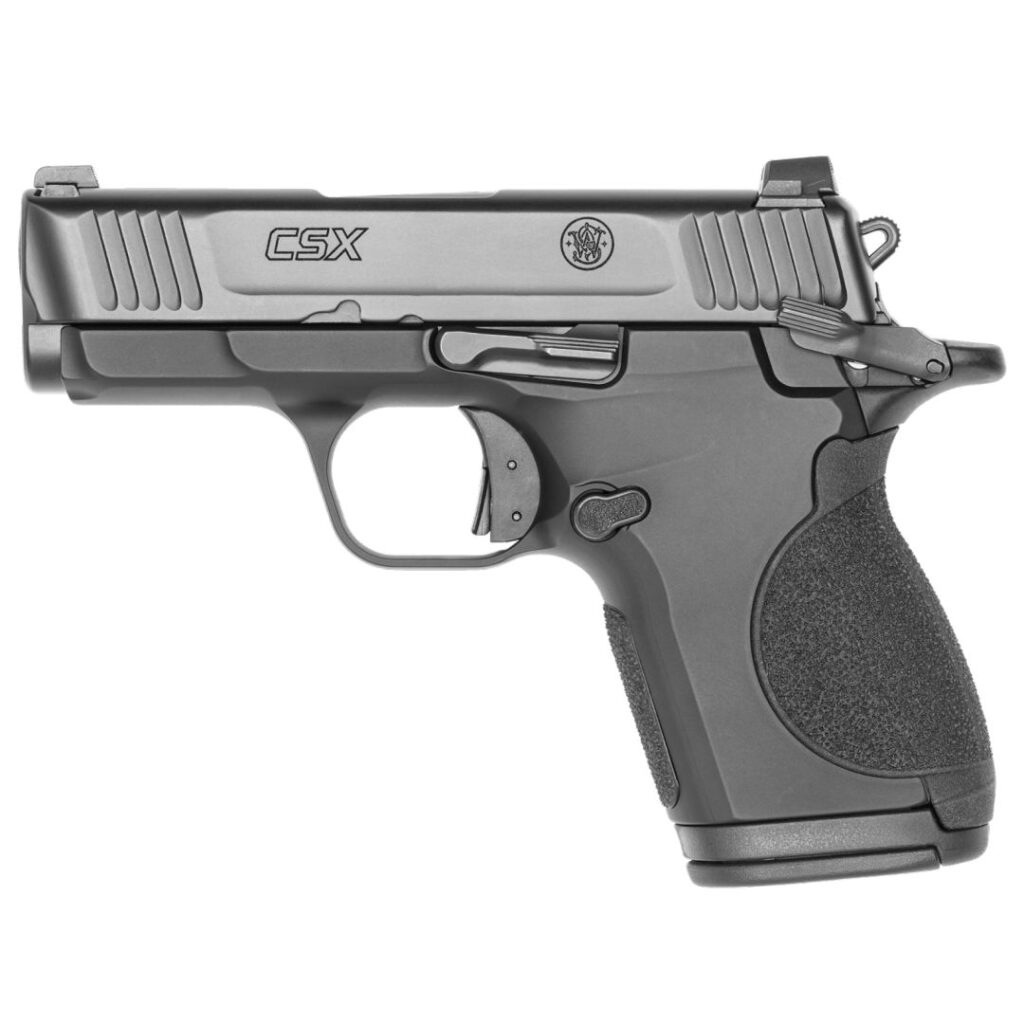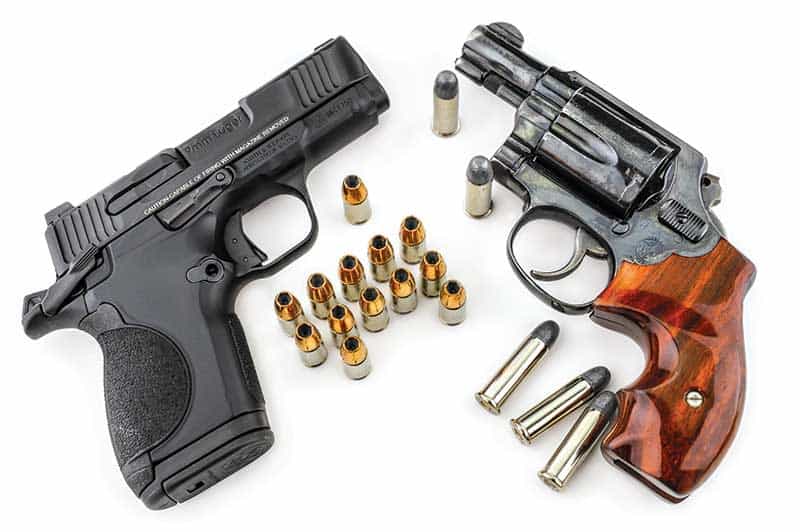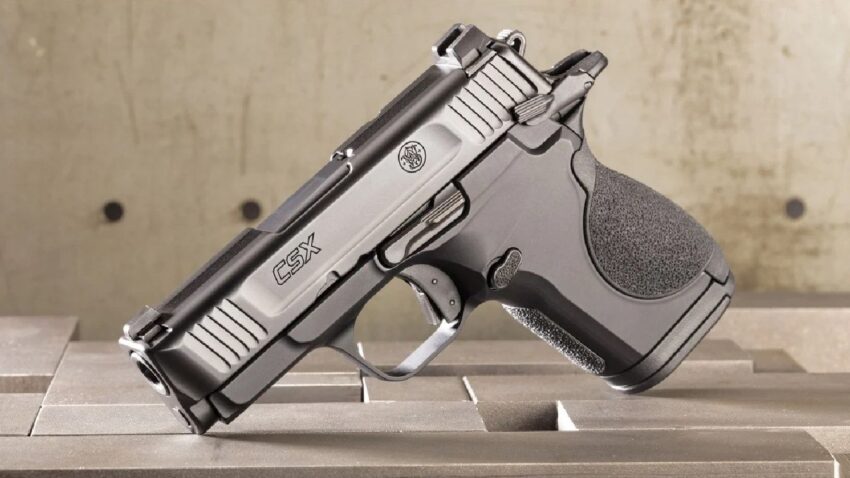Smith & Wesson introduced CSX, a micro-compact, single-action, hammer-fired 9mm in January 2022. One of the newest micro 9mm pistols to enter the market is the Smith & Wesson CSX, but it stands out thanks to some distinctive design elements. What are Smith & Wesson CSX’s benefits and drawbacks then?
Please continue reading if you want to learn more about Smith & Wesson CSX.
Specs And Features Of Smith & Wesson CSX
Specs
- Caliber: 9mm (+P OK)
- Capacity: 10+1 rounds or 12+1 rounds
- Barrel: Stainless steel, 3.1-inch, 1:10 Twist
- Dimensions: 6.1 inches (L) x 4.12 inches (H) x 1.12 inches (W)
- Weight: 19.5 ounces
- Frame: Aluminum alloy
- Slide: Stainless steel
- Finish: Armornite black
- Grip: Interchangeable polymer backstraps
- Sights: Metal white dot front/rear
- Trigger: Single action, safety bar, 5 pounds, 12 ounces (measured)
- Safety: Ambidextrous thumb-safety
- Smith & Wesson CSX features
The CSX is one of the smallest micro 9mm pistols available today, and a few key design elements set it apart from most of its rivals. The majority of micro 9mm pistols available today have polymer frames and striker firing mechanisms and for good reason.
The majority of striker-fired pistols are very reliable, and polymer-framed weapons are straightforward, strong, and affordable. Many of the micro 9mm pistols available today are similar except for slight exterior differences in ergonomics and appearance. That standard is not true of CSX.
Aluminum Frame
The Smith & Wesson CSX’s construction on an aluminum frame with a grip texture panel on the front and interchangeable polymer grip panels on the back sets it apart most significantly from the group of current rivals. The panels have a fine, abrasive texture similar to that of sandpaper with a 36-grit rating.
Even with sweaty hands, the grip panels provide a comfortable and secure grip on the otherwise smooth aluminum frame. There is a backstrap that resembles a palm swell installed on the pistol by default, but you can easily swap it out for the included slimmer, minimalist backstrap. The pistol is comfortable to hold, and both backstraps gave my hands great traction.
Although aluminum is softer than steel, it still functions well in this pistol. After about 300 rounds of shooting, I didn’t observe any alarming or peculiar wear between the stainless-steel slide and the slide rails on the aluminum frame.
The majority of AR receivers are made of aluminum, which makes them durable enough to withstand years of abuse and contact with moving steel parts. This should serve as a reminder to skeptics. You receive a metal gun with the CSX that is small, light and has a great grip.
Ambidextrous And Versatile

The Smith & Wesson CSX deviates in another way from the most popular micro 9mm pistols: it fires by a hammer. Both striker- and hammer-fired pistols are trustworthy, but CSX’s hammer-fired design enables it to have a smaller slide and a crisp, short trigger.
A shooter who carries an external hammer also has the option of doing so if they so choose. On closer inspection, the CSX resembles 1911 more than the majority of other micro 9mm pistols.
Although it would be a stretch to call it a 1911 variant, it does have some features in common with some small 1911s, including the barrel and takedown pin, long slide rails, ejector, and controls that are generally 1911-like. Though discreet, all of the controls are simple to use.
The slide stop lever serves as both the takedown pin and the slide stop on the Smith & Wesson CSX field, which strips like a micro-1911. It has a self-contained guide rod and recoil spring, and its barrel and feed ramp resemble some micro 1911s. Similar to many striker-fired weapons, the CSX has a sizable external extractor that improves reliability.
On the left and right sides of the pistol, the CSX has slide-stop levers. Although the pistol ships with a left-side magazine catch button, a right-side button is also included. Thumb safety levers are present on the left and right sides of the CSX right out of the box.
Because the pivot point for the safety lever is further back on the beavertail, the thumb safety operates and feels like 1911, but it is more smoothly operable. Compared to shorter levers, it is easier to pull.
Some thumb safeties are challenging to release without letting go of the handle, but the CSX’s safety can be released simply by pressing down on the side of my thumb.
Pros & Cons Of Smith & Wesson CSX
Pros
- Highly concealable
- Reliable
- Ambidextrous controls (safety, slide release, reversible mag release)
- Lots of extra details
Cons
- Difficult takedown
- No included takedown tool
- Challenging for big hands
Red-dot Options Of Smith & Wesson CSX
This weapon begs for a red-dot option. I have no idea why Smith & Wesson didn’t introduce a red-dot-compatible model at the beginning. They might later, I do think.
A somewhat retro business is Smith & Wesson. They might believe that this gun is not intended for your typical red-dot user and is instead somewhat more elegant.
Controls Of Smith & Wesson CSX
The Smith & Wesson CSX controls are the review’s standout feature. Regarding the controls on this gun, Smith & Wesson actually did a surprisingly good job.
Safety
This gun has two safety features: trigger safety and what I would call external safety at the thumb.
This security is very discreet, but it’s still very helpful and simple to use. The majority of users’ usability would increase without the ability to carry concealed being compromised by slightly expanding that safety.

However, despite being small and unassuming, safety does an excellent job. Both right- and left-handed users will have the same experience because it is ambidextrous and perfectly matched on both sides.
Magazine Release
The pistol is configured for a right-handed shooter and has the magazine release installed on the left side. A left-handed shooter can use the additional magazine release that is included in the box.
The CSX magazine releases are identical to its safety in every way. For those with large hands, it’s simple to reach the magazine release itself. To get to this magazine release, you might need to loosen your grip if you have hands that are medium to small in size.
I don’t see this release accidentally being pressed while releasing the magazine from the firearm because it’s well-protected and sits relatively low in the gun’s frame.
There is a slight hump on the frame right in front of the magazine release that I can see being uncomfortable for shooters with larger hands if they are depressing the magazine release.
Slide Stop
The fact that the ambidextrous slide stops on this gun are nearly identical on both sides makes it extremely special considering its size. Users won’t notice a difference when using the slide stops despite a slight difference between the two of them.
The right-side slide stop, which is designed for shooters who use their left hand, is a little bit more difficult to use than the left-side stop. For right-handed shooters, Smith & Wesson facilitated things a little. They make up the majority of the buyers of this weapon.
Smith & Wesson did a fantastic job, and these are very low-profile.
Shooting Of Smith & Wesson CSX
Things start to get interesting when you start using this gun.
It is extremely difficult to fit the tenth round into the 10-round magazine when loading the gun. Because the spring and follower were not installed properly, the magazine swelled, making it impossible to seat.
If you compare the 10-round magazine to the 12-round magazine, you’ll notice that the 10-round magazine has a plastic insert built into the base pad. This makes me think that, if the base pad and insert hadn’t been used, the 10-round magazine would have held 11 rounds instead.
That just seems like a total oversight on the part of Smith & Wesson.
Ejections Of Smith & Wesson CSX
You’ll probably hold the magazine’s sleeve while it falls free when you remove the 12-round magazine from the gun unless you completely release your grip.
In order to improve your grip and prevent the magazine from being inserted too deeply into the firearm, the sleeve is there. Although it accomplishes a crucial task, it does so regrettably poorly. For it to stay in place, there isn’t enough surface contact with the magazine itself.
I believe Smith & Wesson would have been better off if they had only provided a 12-round version of the CSX. It would have improved ergonomics and made the gun appear cleaner.
With a 10-round magazine, this gun is only an eighth of an inch shorter than it is with a 12-round magazine. In contrast to the SIG P365, which gains almost half an inch in length by switching to a 12-round magazine, this size comparison is very different.
Read More:

